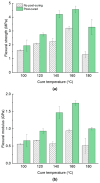Mechanical Properties and Thermal Degradation Behaviour of Polyurethane Composites Incorporating Waste-Glass Particles
- PMID: 40647745
- PMCID: PMC12252175
- DOI: 10.3390/polym17131734
Mechanical Properties and Thermal Degradation Behaviour of Polyurethane Composites Incorporating Waste-Glass Particles
Abstract
This study investigated the effect of hot-pressing conditions, including the curing temperature, curing time and the applied pressure, on the flexural properties of polyurethane (PU) composites incorporating 88 wt.% (Glass/PU-88/12) and 95 wt.% (Glass/PU-95/5) recycled glass particles. Hot-pressing (cure) temperatures between 100 °C and 180 °C were investigated with the objective to shorten the cure cycle, thereby increasing the production rate of the glass/PU composites to match industrial scales. The hot-pressing time varied between 1 min and 30 min, while the pressure varied between 1.1 MPa and 6.6 MPa. Further to investigating the hot-pressing conditions, the effect of post-curing on the flexural properties of glass/PU composites was also investigated. Microstructural analysis was used to identify the interactions between the glass particles and the PU matrix, explore the void content and establish the relationship between the microstructure and the mechanical properties of the resultant glass/PU composites. Glass/PU composites incorporating 5 wt.% (Glass/PU-95/5), 10 wt.% (Glass/PU-90/10) and 12 wt.% (Glass/PU-88/12) were manufactured under optimised hot-pressing conditions (temperature = 100 °C; cure time = 1 min; pressure = 6.6 MPa) and evaluated under flexural, tensile and compression loadings. Furthermore, the high-temperature stability of the composites was evaluated using thermogravimetric analysis. This study demonstrates the feasibility of upcycling glass waste into value-added materials for potential use in the construction and building industry.
Keywords: construction and building; glass/PU composites; mechanical properties; optimised manufacturing process; upcycling glass waste.
Conflict of interest statement
The authors declare that this study received funding from Livefield Pty Ltd. The funder was not involved in the study design, collection, analysis, interpretation of data, the writing of this article or the decision to submit it for publication.
Figures











Similar articles
-
Synchronous Improvement of Mechanical and Room-Temperature Damping Performance in Light-Weight Polyurethane Composites by a Simple Carbon-Coating Strategy.Polymers (Basel). 2025 Jul 31;17(15):2115. doi: 10.3390/polym17152115. Polymers (Basel). 2025. PMID: 40808163 Free PMC article.
-
Exploring the Thermal and Mechanical Properties of Thermoset-Based Composites Reinforced with New Continuous and Chopped Phosphate Glass Fibers.Polymers (Basel). 2025 Jun 11;17(12):1627. doi: 10.3390/polym17121627. Polymers (Basel). 2025. PMID: 40574155 Free PMC article.
-
Optimisation of areca nut husk-derived cellulose nanofibers for enhancing the mechanical properties of epoxy composites using response surface methodology.Sci Rep. 2025 Jul 19;15(1):26211. doi: 10.1038/s41598-025-11415-x. Sci Rep. 2025. PMID: 40683946 Free PMC article.
-
Thermal stability and storage of human insulin.Cochrane Database Syst Rev. 2023 Nov 6;11(11):CD015385. doi: 10.1002/14651858.CD015385.pub2. Cochrane Database Syst Rev. 2023. PMID: 37930742 Free PMC article.
-
Clinical efficacy of resin-based direct posterior restorations and glass-ionomer restorations - An updated meta-analysis of clinical outcome parameters.Dent Mater. 2022 May;38(5):e109-e135. doi: 10.1016/j.dental.2021.10.018. Epub 2022 Feb 24. Dent Mater. 2022. PMID: 35221127
References
-
- Xin Y., Robert D., Mohajerani A., Tran P., Pramanik B.K. Transformation of waste-contaminated glass dust in sustainable fired clay bricks. Case Stud. Constr. Mater. 2023;18:e01717. doi: 10.1016/j.cscm.2022.e01717. - DOI
-
- Taurino R., Bondioli F., Messori M. Use of different kinds of waste in the construction of new polymer composites: Review. Mater. Today Sustain. 2023;21:100298. doi: 10.1016/j.mtsust.2022.100298. - DOI
Grants and funding
LinkOut - more resources
Full Text Sources

